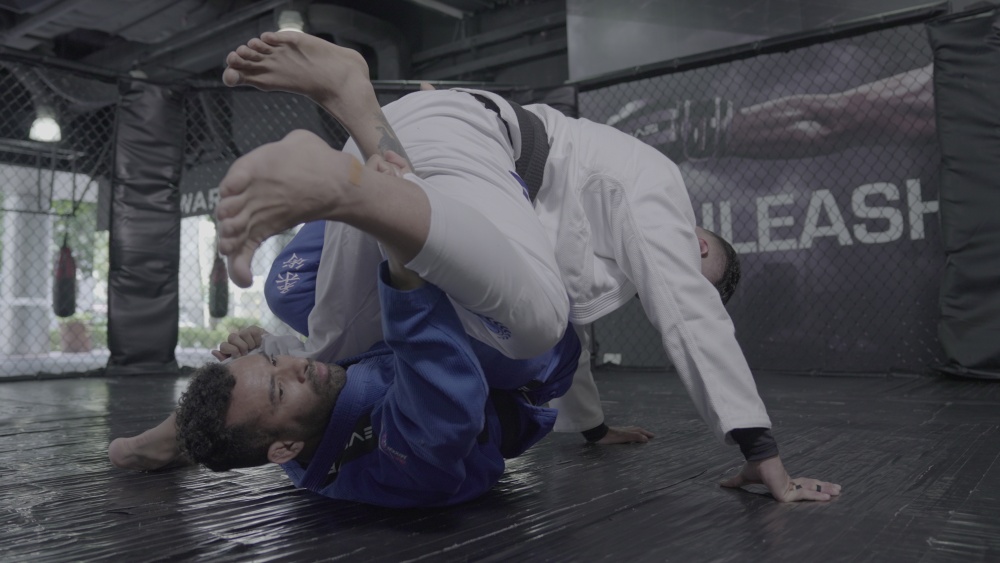Guest post by Evolve MMA, Asia’s premier championship brand for martial arts. It has the most number of World Champions on the planet. Named as the #1 ranked martial arts organization in Asia by CNN, Yahoo! Sports, FOX Sports, Evolve MMA is the top rated BJJ gym in Singapore.
Having mobility and flexibility is always a plus in martial arts. The same can be said when it comes to BJJ. Jiu-Jitsu is a grappling martial art where a lot of inverting happens, especially when the grappler is at the bottom playing guard.
Turning your body upside down prevents the top player from pinning you on the mat while opening many opportunities for the bottom player to apply different guards, submissions, sweeps, or enter leg entanglements. This article will discuss a guard you can use in the inverted position, the tornado guard.
The Tornado Guard
The tornado guard, also known as the Roleta guard, is a type of inverted guard Roberto “Roleta” Magalhães created in the 1990s. Usually, inverting is used in BJJ to create distance against the opponent as they try to pass the guard. While this guard was created by Roberto Magalhães, with slight modifications, it was popularized in the modern grappling scene by Roberto “Cyborg” Abreu. A key difference between the Roleta and tornado guards lies in the entry of the technique. The Roleta typically starts from the closed or open guard, while the Tornado starts from the half guard. Nevertheless, both entries can end up in the exact desired inverted position.
How To Perform The Tornado Guard
To make the tornado guard work, you will be required to be upside down. Understand that one of your legs will always be underneath the opponent, as most positions start from half-guard. It is an integral part of the tornado guard because you must put the opponent’s weight on your leg. Your other leg will be used as a pendulum to find the exact leverage for your position.
Starting from the half-guard, a vital detail is that you should always grab the opponent’s bottom leg where you apply your half-guard. This is because you have to open your guard and invert, and by doing so, you are trapping the opponent with you.
From there, turn upside down. Once inverted, don’t rely solely on your power, as heavier grapplers can use their weight to stack you. It is crucial to get in the proper position as you place yourself underneath the opponent to effectively use your hips to lift them while your other leg is used as a pendulum.
A successful tornado guard can directly sweep the opponent. Depending on the opponent’s reaction, you can transition to different submissions, like the triangle and omoplata. If the opponent gets tight on your leg after you invert, all their weight is on your leg. This means that you can use the pendulum to throw them. Now, if the opponent sprawls and puts their hands on the mat, you can transition to triangle, omoplata, or even take their back.
Submissions From The Tornado Guard
After inverting, it can be challenging to sweep heavier opponents, especially if they start posturing up while posting their hands on the mat. When this happens, step on their hip with your free leg to bring your trapped leg free, so you can move it outside beside their lat. Once done, you can switch their posting hand on the mat to your hip and roll over for the omoplata.
If their hand is firmly posted on the mat, you can grab their tricep and swing your free leg, using it as a pendulum while using the inside of your thigh on the other side to chop on their neck. As soon as you are in the triangle position where you can grab your shin, secure the triangle, and finish the submission as soon as you get the angle. If you can’t lock it straight away, you can always use your leg to push on their hip to create a better angle to ensure that their arms are across your chest in case they start posturing up.
Tornado Guard To Saddle Entry
If you like leg locks, you can use the tornado guard to enter the saddle/411 position. After inverting, you can go for the saddle position on the opponent’s far leg instead of going for the sweep. Starting from the half-guard with your shin on their bicep, invert with your hand outside the opponent’s knee to pull them over you while your head is between their legs. Grab your shin and set your foot on the outside of your leg to keep the opponent locked down.
Use your other foot to travel on their far hip and push off as you invert again, bringing your hand between their knees. Your other hand grabs their far leg, which is then placed by your knee behind the opponent’s knee. Keep holding their leg with your hand to prevent them from facing out as you end up in the saddle. You can finish with different leg locks once you enter the saddle position.
Drills For Inversion
The wall shoulder roll is one of the best drills you can perform to acquire the mobility and flexibility required for inversion. While this drill is typically done to practice getting in the crab ride position, it is perfect for getting you comfortable with inverting. Using the wall with the drill makes it easier to simulate the movement. When you invert to your shoulder, you need to be able to extend your legs using force to control the opponent while using your spine and posture to get to the proper position.
As you do the drill, it is important to put your feet on the wall, push off your feet, and pop your head outside. When you are in the inverted position while facing the wall, your spine should be aligned so that your feet can generate force. This is handy when trying to elevate the opponent’s hips off the ground and get underneath them.
Conclusion
The tornado guard will surely elevate your game if you are a half-guard player. Remember that you must get comfortable inverting when doing this guard. Warm up before each session and perform mobility exercises to prevent injuries when attempting the tornado guard in sparring.
Roberto “Cyborg” Abreu is one of the most accomplished grapplers on the planet. He is an ADCC open weight Champion.
The post How To Use the Tornado Guard In BJJ appeared first on Bjj Eastern Europe.


